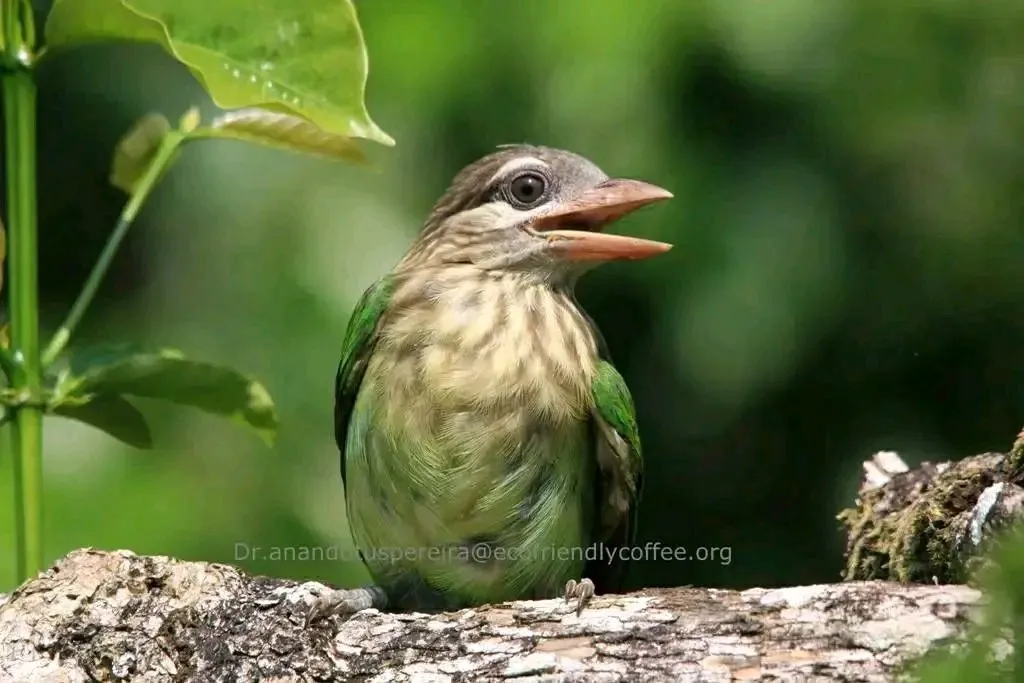by Dr. Anand Titus and Geeta N. Pereira
Introduction
The Indian coffee ecosystem harbor’s thousands of species of old diverse and significant species of rare birds, endemic bird species and endangered wildlife living in complete harmony. Coffee planters play a crucial role in protecting birds within their coffee-growing landscapes. Many coffee plantations in India follow the traditional practice of shade-grown coffee, where coffee plants are grown under a canopy of trees. This mimics the natural forest ecosystem and provides habitat for a variety of bird species. The shade trees provide nesting sites, food sources, and shelter for birds, contributing to increased biodiversity.
This article throws light on the White Cheeked Barbet, commonly observed inside Indian Shade coffee.
Habitat
The natural ecosystems and habitats of these white-cheeked barbet species include tropical and subtropical dry forests, tropical and subtropical moist lowland forests, evergreen forests and moist montane forests.
Scientific Classification
KINGDOM Animalia
PHYLUM Chordata
CLASS Aves
ORDER Piciformes
FAMILY Megalaimidae
GENUS Psilopogon
SPECIES Psilopogon viridis

Description
Its characteristic feature is a broad white cheek stripe below the eye and a distinctive supercilium.
Appearance
The white-cheeked barbet also referred to as the small green barbet is 16.5–18.5 cm (6.5–7.3 in) in length. It has a brownish head streaked with white, sometimes giving it a capped appearance. It is easy to identify the bird by its characteristic white patterns on its face: a white patch around the ear-coverts, a white line above the eye, and a white throat.
Behavior
This barbet nests and roosts in excavated tree hollows, and is aggressive and territorial, competing fiercely with other barbets for suitable nest sites. While foraging they are quite aggressive and will attempt to chase other barbets, Koels and other frugivores
Beak
The white-cheeked barbet has a pale pink, stout bill with bristles around it.
Feet
The feet are pale grey.
Distribution/Range
The white-cheeked barbet is mostly observed in the coffee forests of South India, and is endemic especially to the forest areas of the Western Ghats, parts of the Eastern Ghats and adjoining hills.
Communication and Perception
Calls / Vocalization
During the breeding season, their calls are loud and unmistakable. The call, a monotonous ‘Kot-roo … Kotroo…’
Courtship
During the breeding season which begins at the start of summer their calls become loud and constant especially in the mornings.
Breeding
They begin breeding in December and continue to nest until May. They are believed to form a pair bond that lasts for longer than a single breeding season. Courtship feeding of the female by the male is usual prior to copulation.
Nesting
These barbet birds build their nests in holes in trees, bamboo stalks, or sometimes in dead branches. These birds excavate nesting cavities, and both males and females excavate the nest. It carves out holes inside a tree to build its nest. Both sexes excavate the nest and it can take about 20 days to complete the nest. They may reuse the same nest tree each year but often excavate a new entrance hole.
Eggs are laid about 3–5 days after nest excavation. About 3 eggs are laid. The incubation period is 14 to 15 days. During the day both sexes incubate, but at night, only the female sits on the eggs. Both the parents feed and protect the chicks till they fledge by the sixth week. Usually, two broods are raised in a year. They are monogamous and territorial.
The young leave the nest after 36 to 38 days.
Diet/Feeding
Like all other Asian barbets, they are mainly frugivorous (although they may sometimes eat insects), and use their bills to excavate nest cavities in trees.
Flight
White-cheeked barbets have a typical flight pattern that includes strong wingbeats followed by a dipping phase with the wings folded against the body.
Migration
Not a migrant but they may make local movements for feeding and breeding within their range.
Threats
Habitat loss is thought to pose by far the greatest threat to birds, both directly and indirectly. Destruction and fragmentation of habitat. Pet trade too is a contributing factor for the decline.
Conservation Status
Personal Observations
Due to the large number of fig trees inside the coffee plantation and these trees fruiting thrice a year, barbets harvest on the berries during the early morning and in the evenings. They are green in colour and sit still, making them difficult to spot.
Barbets regurgitate seeds and indigestible parts of the fruit of wild trees, enabling forests to flourish and grow.
Ecosystem Roles
These barbets play an important role in forests as seed dispersal agents. They also visit the flowers of Bombax for nectar and may be involved in pollination.
Lifespan/Longevity
According to birdworld.com, the white-cheeked barbet has a generation length of 8.5 years.
Conclusion
Birds are often referred to as a barometer for the health of our planet. They are ‘ecosystem engineers’ thanks to their role as seed dispersers and pollinators. However, in the recent past, we have noticed an alarming decline in bird populations in ecofriendly shade coffee plantations due to Habitat loss, climate change and disease. We have observed many of the Ficus trees, as well as other wild fruit bearing trees, not yielding fruit resulting in scarcity of food, especially for frugivorous birds like barbets. It has been seen that some of the birds are very adaptive and change their habits to adapt to new environments. But generally, they are under pressure and deserve much more attention than they get.
References
Anand T Pereira and Geeta N Pereira. 2009. Shade Grown Ecofriendly Indian Coffee. Volume-1.
Bopanna, P.T. 2011.The Romance of Indian Coffee. Prism Books ltd.